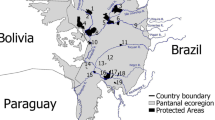Abstract.
In the arid regions of Tunisia, considerable investments are being made to maintain the old water harvesting techniques and introduce new ones to capture the scarce amount of rainwater (100 mm to 230 mm annually) for agricultural and domestic purposes. However, no detailed assessment of the multiple effects and the costs and benefits of these techniques have been made so far. This paper summarizes the results of an in depth investigation of the multiple impacts (runoff mobilization, ground water recharge, agro-socio-economic impacts) of the water harvesting works undertaken in the watershed of oued Oum Zessar (southeastern Tunisia). The importance of interdisciplinary and integrated approaches was revealed through this detailed impact assessment and economic evaluation. In fact, the profitability of the water harvesting works depends largely on the criteria chosen. However, further refinements are needed to better include all possible impacts (positive and negative) that occur as a result of the installation of the water harvesting structures.
Similar content being viewed by others
References
Ben Mechlia, N. and Ouessar, M.: 2004, ‘Water Harvesting Systems in Tunisia,’ in: Th. Oweis and A. Bruggeman(eds), Indigenous Water Harvesting Systems in West Asia and North Africa, ICARDA Publications, Aleppo, Syria, pp. 21–41.
Biesemans, J.: 2000, ‘Erosion Modelling as Support for Land Management in the Loss Belt of Flanders.’ Ph.D. Thesis, Gent University, Belgium.
Derouiche, R: 1997, Contribution à l’étude par modèle numerique de l’impact des aménagements de CES sur la recharge de la nappe de Zeuss-Koutine. Mémoire de in d’études, INAT, p. 68.
El Amami, Sl.: 1984, Les aménagements hydrauliques traditionnels en Tunisie. CRGR, Tunis.
Ennabli, N.: 1993, Les aménagements hydrauliques et hydro-agricoles traditionnels en Tunisie. Imprimerie Officielle de la République Tunisienne, Tunis, 255 pp.
FAO & World Bank: 1994, Analyse économique de projets concernant les ressources naturelles en Tunisie. Une application du modèle FORCES-MOD aux bassins versants de Bou Hertma et de Marguellil. Ministère de l’Agriculture, Tunis.
Fauck R., Makhlouf, Ez., Bachta, M.S., Laamary, M. and Marouani, A.: 1991, Rapport d’évaluation sur les techniques de CES en Tunisie. D-CES / Projet PNUD/FAO Tun 86-020.
Floret, C. and Pontanier, R.: 1982, L’aridité en Tunisie présaharienne: Climat, sol, végétation et aménagement. ORSTOM, Paris, p. 544.
Harris, H.: 1991, ‘Implications of Climatic Variability,’ in: H. Harris, P.J.M. Cooper, and M. Pala, (eds.), Proceedings of the Symposium Soil and Crop Management for Improved Water Use Effeciency in Rainfed Areas, 21–34, ICARDA, Syria, p. 357.
Hénia, L.: 1993, ‘Climat et bilans de l’eau en Tunisie: Essais de régionalisation climatique par les bilans hydriques.’ Publication de l’Université de Tunis I, série Géographie, p. 391.
Mini. Agri. (Ministère de l’Agriculture): 1990a, ‘La stratégie nationale de la conservation des eaux et du sol (1990–2000). p. 29.
Mini. Agri. (Ministère de l’Agriculture): 1990b, La stratégie nationale des ressources en eau (1990–2000).
WAHIA 1999. Opening Seminar report. WAU, Wageningen.
WAHIA 2000. First Annual Report. WAU, Wageningen.
Author information
Authors and Affiliations
Corresponding author
Rights and permissions
About this article
Cite this article
Ouessar, M., Sghaier, M., Mahdhi, N. et al. An Integrated Approach for Impact Assessment of Water Harvesting Techniques in Dry Areas: The Case of Oued Oum Zessar Watershed (Tunisia). Environ Monit Assess 99, 127–140 (2004). https://doi.org/10.1007/s10661-004-4013-7
Issue Date:
DOI: https://doi.org/10.1007/s10661-004-4013-7




